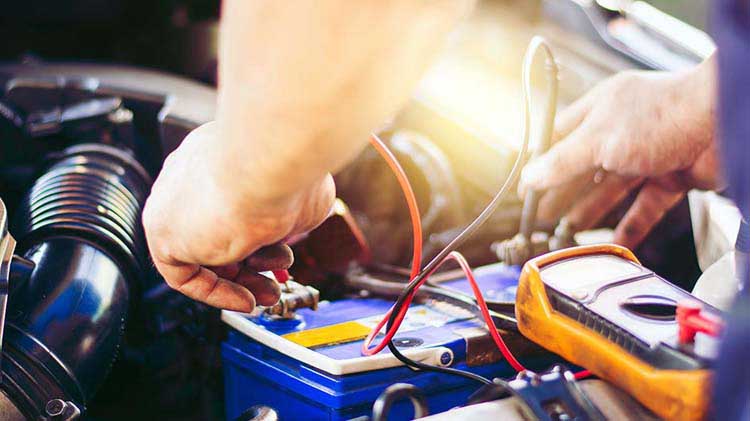Стартерная батарея локомотива: обеспечение надежной работы железнодорожных двигателей
Railway engines are the backbone of the transportation industry, and they are powered by locomotive starter batteries. These batteries are designed to provide the necessary energy to start the engine and power its auxiliary systems. Locomotive starter batteries are an essential component of the railway industry, and they have been used for decades to keep the trains running on time.
This article will explore the different types of locomotive starter batteries, their features, and how they help to power up railway engines with reliable performance.
Types of Locomotive Starter Batteries
There are two types of locomotive starter batteries: lead-acid batteries and nickel-cadmium batteries. Lead-acid batteries are the most common type of locomotive starter battery and are widely used in the railway industry. They are reliable, cost-effective, and have a long service life. Nickel-cadmium batteries are also used in locomotive starter applications, but they are less common due to their higher cost.
Features of Locomotive Starter Batteries
Locomotive starter batteries are designed to withstand the harsh environment of a railway engine. They are built to be durable, reliable, and able to provide the necessary energy to start the engine in all weather conditions. These batteries are also designed to withstand the constant vibration and shock that occurs during the operation of a train.
One of the essential features of a locomotive starter battery is its capacity. The capacity of the battery determines how much energy it can store and how long it can power the engine\’s starter motor and auxiliary systems. The capacity of a locomotive starter battery is usually measured in ampere-hours (Ah).
Another critical feature of a locomotive starter battery is its voltage. The voltage of the battery determines how much power it can provide to the engine\’s starter motor and auxiliary systems. The voltage of a locomotive starter battery is typically around 24 volts.
How Locomotive Starter Batteries Help to Power Up Railway Engines
Locomotive starter batteries are essential to the operation of a railway engine. They provide the necessary energy to start the engine and power its auxiliary systems. Without a reliable locomotive starter battery, the engine would not be able to start, and the train would not be able to move.

When a train is not in use, the locomotive starter battery is continually charged by an onboard generator. The battery stores this energy, which is then used to power the engine\’s starter motor and auxiliary systems when the train is ready to start. The battery also powers the engine\’s lighting, air conditioning, and other systems when the engine is not running.
Reliability is key when it comes to locomotive starter batteries. A failed battery can cause delays, disruption, and even safety issues. That\’s why it\’s essential to use high-quality batteries that are designed to withstand the harsh environment of a railway engine.
Заключение
In conclusion, locomotive starter batteries are an essential component of the railway industry. They provide the necessary energy to start the engine and power its auxiliary systems. Locomotive starter batteries are built to be durable, reliable, and able to withstand the harsh environment of a railway engine. The two most common types of locomotive starter batteries are lead-acid batteries and nickel-cadmium batteries. When it comes to powering up railway engines with reliable performance, a high-quality locomotive starter battery is a must-have.
-
 Introduction In recent years, the advancements in technology have revolutionized various sectors, including the military. One significant development is the application of lithium batteries in military equipment. Lithium batteries have become the preferred choice due to their high energy density, lightweight nature, and extended lifespan. This article aims to discuss the advancements of lithium batteries in military equipment, highlighting their...Читать далее
Introduction In recent years, the advancements in technology have revolutionized various sectors, including the military. One significant development is the application of lithium batteries in military equipment. Lithium batteries have become the preferred choice due to their high energy density, lightweight nature, and extended lifespan. This article aims to discuss the advancements of lithium batteries in military equipment, highlighting their...Читать далее -
 The world is facing a crucial challenge in meeting its ever-growing energy demands while also transitioning towards sustainable and renewable sources. Traditional power grids are struggling to keep up with the increasing demand, leading to frequent blackouts and an unstable energy supply. To address this issue, a new technology has emerged that has the potential to revolutionize the energy landscape:...Читать далее
The world is facing a crucial challenge in meeting its ever-growing energy demands while also transitioning towards sustainable and renewable sources. Traditional power grids are struggling to keep up with the increasing demand, leading to frequent blackouts and an unstable energy supply. To address this issue, a new technology has emerged that has the potential to revolutionize the energy landscape:...Читать далее -
 Введение: Гольф-кары стали распространенным видом транспорта на полях для гольфа, в жилых комплексах и даже в некоторых жилых районах. Эти компактные электромобили не только удобны, но и экологичны. Однако производительность и долговечность гольф-мобиля во многом зависят от качества и обслуживания его аккумулятора. В этой статье мы рассмотрим важность...Читать далее
Введение: Гольф-кары стали распространенным видом транспорта на полях для гольфа, в жилых комплексах и даже в некоторых жилых районах. Эти компактные электромобили не только удобны, но и экологичны. Однако производительность и долговечность гольф-мобиля во многом зависят от качества и обслуживания его аккумулятора. В этой статье мы рассмотрим важность...Читать далее -
 Введение: Базовые станции связи являются основой наших современных сетей беспроводной связи. Они обеспечивают передачу и прием сигналов между мобильными устройствами и сетевой инфраструктурой. Этим базовым станциям требуется надежный и эффективный источник питания для обеспечения бесперебойных услуг связи. В последние годы технология литиевых батарей стала многообещающим решением для оптимизации производительности...Читать далее
Введение: Базовые станции связи являются основой наших современных сетей беспроводной связи. Они обеспечивают передачу и прием сигналов между мобильными устройствами и сетевой инфраструктурой. Этим базовым станциям требуется надежный и эффективный источник питания для обеспечения бесперебойных услуг связи. В последние годы технология литиевых батарей стала многообещающим решением для оптимизации производительности...Читать далее -
 In modern society, portable electronic products have become an indispensable part of our lives. Lithium batteries, as the core power source of these devices, have brought great convenience to our lives because of their lightness and efficiency. Whether it is a smartphone, tablet or wearable device, lithium batteries provide us with a longer and more reliable use experience with their...Читать далее
In modern society, portable electronic products have become an indispensable part of our lives. Lithium batteries, as the core power source of these devices, have brought great convenience to our lives because of their lightness and efficiency. Whether it is a smartphone, tablet or wearable device, lithium batteries provide us with a longer and more reliable use experience with their...Читать далее -
 A locomotive starter battery is an essential component of any locomotive engine. Without a reliable power source, the engine cannot be started, and the locomotive cannot move. In this article, we will discuss the importance of a locomotive starter battery and how it works.Firstly, let\'s discuss what a locomotive starter battery is. It is a heavy-duty battery that is designed...Читать далее
A locomotive starter battery is an essential component of any locomotive engine. Without a reliable power source, the engine cannot be started, and the locomotive cannot move. In this article, we will discuss the importance of a locomotive starter battery and how it works.Firstly, let\'s discuss what a locomotive starter battery is. It is a heavy-duty battery that is designed...Читать далее -
 В связи с растущим спросом на надежные и эффективные решения для электропитания в крупномасштабных приложениях промышленные зарядные устройства для аккумуляторов стали ключевыми игроками в отрасли. Эти зарядные устройства специально разработаны для обеспечения эффективной зарядки и управления питанием для широкого спектра промышленных применений, включая производственные предприятия, склады и транспортные системы. В этой статье мы рассмотрим особенности и преимущества...Читать далее
В связи с растущим спросом на надежные и эффективные решения для электропитания в крупномасштабных приложениях промышленные зарядные устройства для аккумуляторов стали ключевыми игроками в отрасли. Эти зарядные устройства специально разработаны для обеспечения эффективной зарядки и управления питанием для широкого спектра промышленных применений, включая производственные предприятия, склады и транспортные системы. В этой статье мы рассмотрим особенности и преимущества...Читать далее

